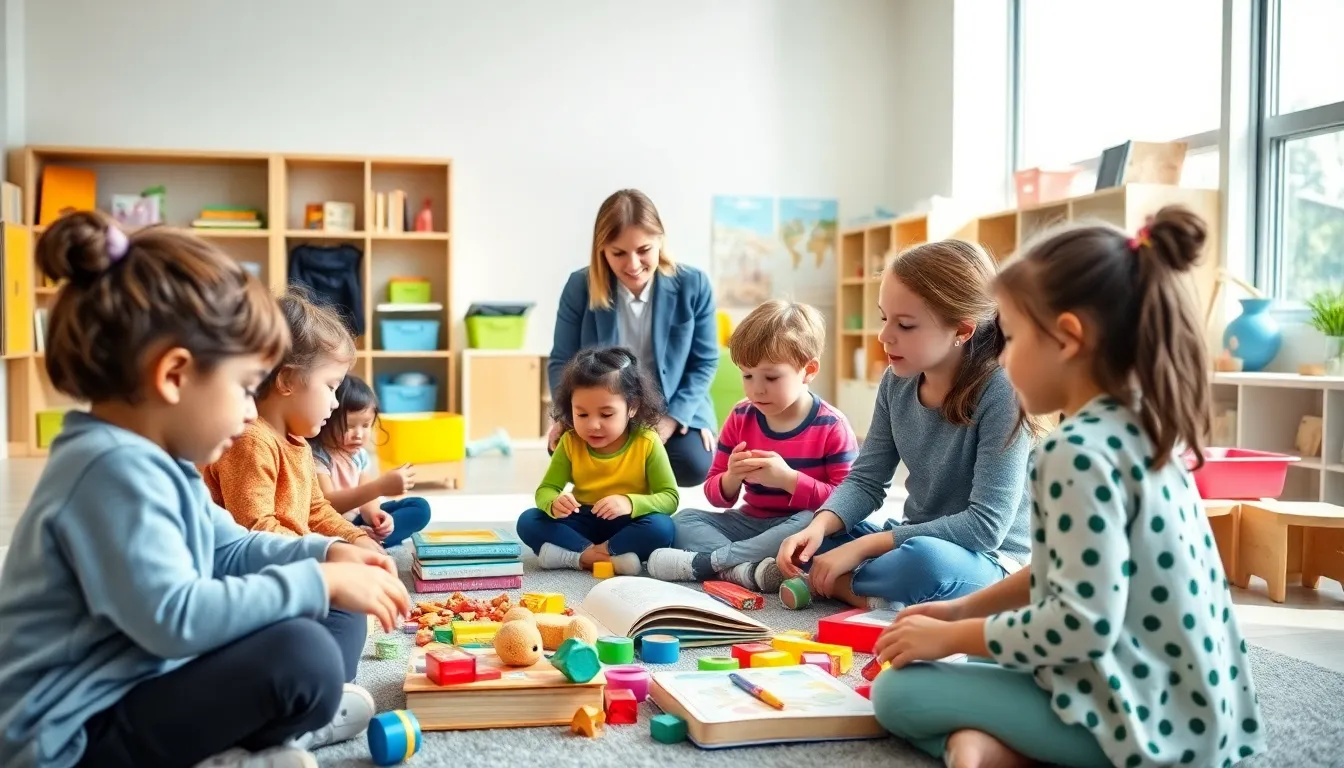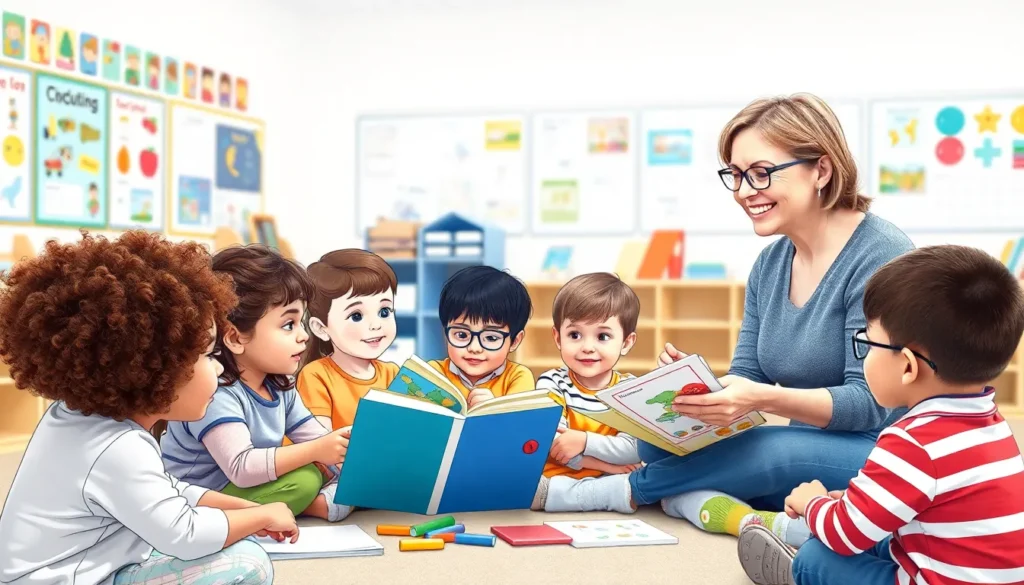Table of Contents
ToggleIn a world where emojis often replace words and autocorrect can turn a simple text into a comedy of errors, keeping tabs on language growth is more important than ever. Language growth monitoring isn’t just for linguists in lab coats; it’s for parents, educators, and anyone who wants to ensure that communication skills are thriving. After all, who wouldn’t want their child to express themselves clearly, rather than relying on an interpretive dance to convey their feelings?
Overview of Language Growth Monitoring
Language growth monitoring involves systematically assessing a child’s language skills over time. This process helps identify strengths and areas for development in communication abilities. Regular assessments provide insights into how well children articulate thoughts and engage in conversations.
Tracking language growth can include a variety of methods. Observations in natural settings allow for the evaluation of verbal interactions during play or social activities. Standardized tests provide measurable data regarding vocabulary and grammar usage. Also, parent and educator feedback plays a crucial role in understanding a child’s communication progress.
Effective monitoring fosters early intervention when necessary. Parents and educators can use this information to tailor learning experiences, ensuring they meet individual needs. Progress notes can highlight specific milestones or achievements, reinforcing positive development. This approach encourages children to communicate more confidently and clearly.
Research suggests that continuous language assessment promotes better outcomes. Studies indicate that children receiving targeted support demonstrate improved language skills over time. Engaging children in activities that stimulate language use can further enhance these outcomes.
Monitoring language growth isn’t just about assessments; it’s about building relationships. Encouraging dialogue between children, parents, and educators creates a supportive environment for language development. The combination of assessment and interaction cultivates a culture of communication that benefits all parties involved.
Importance of Language Growth Monitoring

Monitoring language growth plays a crucial role in developing effective communication skills. This practice ensures that children express themselves clearly, setting a foundation for successful interaction in various contexts.
Benefits for Children
Children experience numerous advantages from language growth monitoring. Increased confidence emerges as they acquire language skills, allowing them to share thoughts and feelings without relying on non-verbal cues. Enhanced vocabulary use appears when assessment methods reveal areas for improvement, fostering linguistic development. Effective monitoring also supports tailored learning experiences, aligning with individual needs and ensuring optimal understanding. Research shows that early intervention leads to better outcomes, promoting overall language proficiency and social skills. By engaging in regular assessments, children feel encouraged to explore language, boosting their motivation and willingness to learn.
Benefits for Educators
Educators gain significant benefits through language growth monitoring. Access to ongoing assessments provides insights into each child’s language abilities, guiding instructional decisions. Customized learning plans become possible, addressing diverse needs in the classroom. Gathering feedback from parents and analyzing progress offers a comprehensive view of a child’s development, facilitating targeted support. Collaboration strengthens as educators engage in discussions about language milestones, enhancing the learning environment. When educators utilize monitoring practices effectively, they foster better relationships with students, creating a culture of communication that promotes growth and understanding.
Methods of Monitoring Language Growth
Monitoring language growth employs various methods to provide a comprehensive assessment of a child’s language skills. These methods focus on both standardized assessments and observational techniques, ensuring a well-rounded approach.
Standardized Assessments
Standardized assessments evaluate language skills through structured tests. These assessments yield quantifiable results, allowing comparisons against age-appropriate benchmarks. Tools like the Clinical Evaluation of Language Fundamentals (CELF) and the Peabody Picture Vocabulary Test (PPVT) are commonly used. Score ranges help identify language proficiency, noting strengths and weaknesses. Moreover, consistent use of these assessments enables tracking progress over time, fostering early intervention when needed. Educators and therapists can utilize these tools to develop tailored strategies for supporting children effectively.
Observational Techniques
Observational techniques focus on natural language use in everyday settings. Observers gather real-time data during interactions, highlighting language growth in context. Noting details like vocabulary choice, sentence structure, and communicative intent offers valuable insights. This method enables a deeper understanding of how children express themselves in varied situations. Regular observations encourage collaboration among educators, parents, and specialists, enhancing the overall assessment process. Capturing spontaneous moments of communication reveals both natural language abilities and new development opportunities.
Challenges in Implementing Language Growth Monitoring
Implementing language growth monitoring presents several challenges that affect its effectiveness and accessibility.
Access to Resources
Limited access to resources can hinder effective language growth monitoring. Many families lack access to qualified professionals who can conduct assessments, particularly in underserved areas. Educational institutions may face budget constraints, which impacts the availability of testing materials and training programs for staff. Without proper resources, consistent language assessment becomes difficult. Some educators might struggle to gather reliable data due to a shortage of standardized assessment tools or training. Access to technology also plays a role, as digital platforms increase monitoring efficiency. Thus, disparities in resources can prevent comprehensive language growth monitoring.
Variability in Development
Children’s language development varies widely, contributing to challenges in monitoring. Factors like age, exposure to language, and individual learning styles create differences in language skills. Some children may progress rapidly, while others take more time to develop speaking and comprehension abilities. This variability complicates the creation of uniform benchmarks and learning goals. Additionally, cultural and environmental influences shape language use, further complicating assessments. Understanding each child’s unique trajectory requires individualized observation and assessment, which can be resource-intensive. Hence, variability in development poses significant challenges to effective language growth monitoring.
Tools and Resources for Language Growth Monitoring
Various tools and resources support effective language growth monitoring. Assessments like the Clinical Evaluation of Language Fundamentals (CELF) offer standardized testing to measure language skills against age-appropriate benchmarks. These assessments provide quantifiable data, promoting a clear understanding of a child’s progress.
Observational techniques also play a crucial role. Teachers and caregivers can document real-time language use during everyday interactions, highlighting natural vocabulary, sentence structure, and communicative intent. This method captures the nuances of language growth that standardized tests might overlook.
Technology enhances monitoring efforts. Apps such as Language Diary and Speech Blubs facilitate tracking language development through interactive activities and progress reports. These tools allow educators and parents to engage actively in the assessment process, ensuring timely interventions when needed.
Professional development resources strengthen the skills of those involved in language growth monitoring. Workshops, online courses, and webinars equip educators with strategies to implement effective assessment practices. Networking with specialists offers perspectives and tools that enrich the monitoring experience.
Community resources also provide valuable support. Organizations like the American Speech-Language-Hearing Association (ASHA) offer guidelines and recommendations for effective assessment approaches. Utilizing these resources fosters collaboration between parents, educators, and specialists, creating a uniform approach to monitoring language growth.
Continuous access to research-published studies informs best practices in language assessment. Staying updated with recent findings allows for informed decisions in tailoring monitoring strategies. Informed strategies lead to better outcomes for children, aligning individual needs with appropriate interventions.
Monitoring language growth is essential for fostering effective communication skills in children. By employing various assessment methods and tools, parents and educators can identify strengths and areas for improvement. This proactive approach not only enhances children’s confidence and vocabulary but also promotes tailored learning experiences that cater to individual needs.
Building strong relationships through open dialogue between children, parents, and educators creates a supportive environment that encourages language development. Despite the challenges of limited resources and variability in children’s progress, continuous assessment remains a powerful tool for achieving better outcomes. Ultimately, prioritizing language growth monitoring cultivates a culture of communication that benefits children and supports their overall development.







